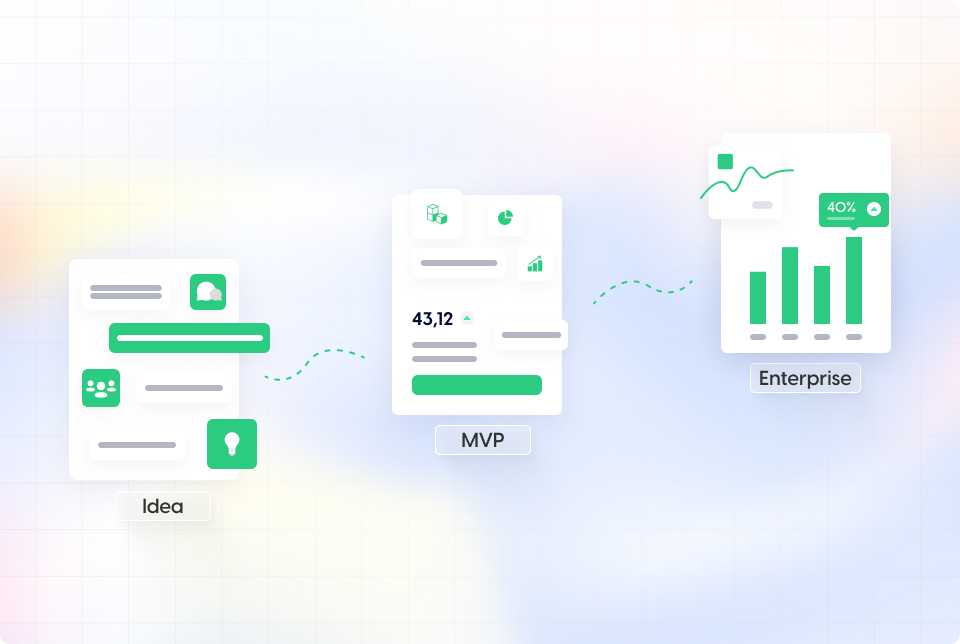
Ivan Traykov
23 Jan
6 mins read
- Copy link
From MVP to Enterprise-Ready: Scaling Your Web App Without Breaking the Bank

Why Modular Design and Incremental Improvements are the Keys to Sustainable Growth
Introduction:
In today’s fast-paced digital marketplace, building a feature-complete application from day one can be a costly gamble. Instead, imagine launching quickly with just enough to delight your early adopters—and then steadily evolving into a powerful, enterprise-ready solution. That’s the magic of the Minimum Viable Product (MVP) mindset, combined with modular design and incremental improvements.
In this guide, you’ll discover how to get your product to market faster, validate it with real user feedback, and scale gracefully—all without draining your resources or risking burnout. If you’re aiming for sustainable growth, keep reading.
1. The MVP Advantage
1.1 Lower Development Costs
An MVP helps you test only the most critical features, avoiding unnecessary expenses on bells and whistles your users might not even want. By focusing on essentials, you minimize upfront costs and free up budget for future improvements.
1.2 Quicker Time to Market
Speed matters. The sooner you release, the sooner you can gather real-world data. Launching fast lets you pivot while it’s still easy (and cheap) to do so, rather than sinking funds and months into a fully built product that misses the mark.
1.3 Real-World Validation
Nothing beats honest feedback from your actual users. With an MVP in their hands, you’ll learn exactly which features resonate—and which ones don’t. This insight helps you make smarter decisions on where to invest next.
Pro Tip: Identify the top 1-3 problems your users face, and tackle them first. Everything else can wait.
2. The Power of Incremental Improvements
2.1 Building on Feedback
Every new feature or tweak should be guided by real-life user behavior. By releasing small, focused updates, you refine the product in a way that genuinely solves user problems—and keeps them coming back.
2.2 Reduce Risk of Overbuilding
Feature bloat is the enemy of usability and budget control. Incremental development keeps your product lean and purposeful, ensuring each new addition has a tangible benefit.
2.3 Flexible Budgeting
Spreading out costs via phased updates allows for more predictable financial planning. This approach keeps cash flow under control and helps you avoid unpleasant surprises.
Pro Tip: Track metrics like feature adoption rate, user retention, and engagement. These data points reveal which features are hitting the mark and which might be siphoning resources unnecessarily.
3. Modular Design: The Secret to Long-Term Scalability
3.1 What Is Modular Design?
Modular design structures your application into self-contained components, each handling a specific function. They can be developed, tested, and maintained independently, reducing headaches down the line.
3.2 The Benefits of Going Modular
Easier Maintenance:
Swap out or update modules without risking the entire system.
Faster Iterations:
Tweak a single module without worrying about a domino effect.
Lower Costs Over Time:
Reusable code and reduced refactoring translate to long-term savings.
3.3 Transitioning from Monolith to Modules
Many new apps start as monoliths (everything bundled together). As you scale, this can become cumbersome. By adopting a modular or microservices architecture early, you’ll sidestep major roadblocks when user traffic skyrockets.
Pro Tip: Even if you build a simple monolith first, keep modularity in mind. Group related functions and maintain clean interfaces so you can “pull out” modules as you grow.
4. Balancing Cost, Quality, and Speed
4.1 Adopt a Phased Approach
Roll out a polished MVP, then plan sprints or phases for future features. This approach keeps costs from ballooning and ensures you’re delivering tangible value at each stage.
4.2 Embrace Lean Methodologies
Agile, Scrum, or Kanban frameworks are perfect for incremental improvements. Short sprints + continuous feedback = quicker course corrections and less wasted effort.
4.3 Outsource Strategically
Sometimes, bringing in outside experts (for example, UI/UX design or advanced security) is more cost-effective than hiring full-time. This strategy ensures top-notch quality without long-term overhead.
Pro Tip: Create a priority-based backlog of features—label them as must-have or nice-to-have. This keeps everyone on the same page and prevents scope creep.
5. When to Scale Up Your Infrastructure
5.1 Monitor Key Performance Indicators (KPIs)
How do you know you’re outgrowing your basic setup? Watch traffic volumes, response times, and resource usage. Frequent slowdowns or downtime are your cues to invest in upgrades.
5.2 Cloud-Based Solutions for Flexibility
Services like AWS, Azure, and Google Cloud let you pay as you go, making it easy to handle traffic spikes without a massive upfront investment in hardware.
5.3 Load Balancing and Caching
Introducing load balancers distributes traffic efficiently, while caching (e.g., using Redis or Memcached) speeds up data retrieval. These tweaks significantly improve user experience—at a fraction of the cost of rebuilding.
Pro Tip: Automate deployments with tools like Docker and Kubernetes to easily replicate environments, roll out new features, and orchestrate containers at scale.
6. Practical Steps to Grow at a Manageable Pace
Validate Your Core Idea
Conduct market research or run a pilot.
Gather initial feedback to refine your MVP’s top features.
Build a Minimal Viable Product (MVP)
Focus on solving
one major
user pain point.
Keep design simple and intuitive.
Implement a Feedback Loop
Use analytics dashboards, user surveys, or heatmaps.
Make it easy for users to suggest improvements.
Prioritize Improvements
Base decisions on real-world data (retention, engagement).
Avoid chasing every shiny object—stick to your roadmap.
Refactor & Modularize
Gradually break monolithic code into separate modules.
Define clear scopes and interfaces for each module.
Scale Infrastructure
Migrate to cloud solutions for on-demand resources.
Use load balancing and caching to handle spikes.
Refine & Repeat
Release updates, collect data, iterate based on insights.
7. How Our Fullstack Web Studio Can Help
At our studio, we thrive on turning big visions into step-by-step success stories. Here’s how:
Strategy & Roadmapping:
We’ll help you nail your MVP’s scope and outline a cost-effective growth plan.
Modular Architecture:
Our development approach ensures each component is upgradable and replaceable as you scale.
Agile Development:
We work in sprints for
fast, transparent
iterations—so you always know where your product stands.
Scalable Infrastructure:
We set you up on flexible hosting solutions and leverage automation to handle traffic surges with ease.
Ongoing Support & Maintenance:
Post-launch, we stay by your side—optimizing performance, adding features, and providing a continuous feedback loop to ensure your product keeps evolving.
8. Final Thoughts and Next Steps
In an era where the digital experience can make or break your brand, adopting an MVP-first mindset with modular design is both practical and profitable. By starting small and focusing on incremental improvements, you’ll keep budgets manageable, validate your product effectively, and set a foundation for smooth expansion.
Ready to Take the First Step?
Don’t wait until your users feel the pain of slow load times and bloated features. Let our fullstack web studio guide you from an MVP that truly resonates—right up to an enterprise-grade platform that scales effortlessly.
Give us a call to explore how we can help turn your vision into a rock-solid, revenue-driving application.